The importance of load balancing Synapse Medical Imaging servers
Load balancers play a crucial role in ensuring the uptime and reliability of servers in the medical imaging sector, particularly those running Synapse, a high-performance, distributed data management and collaborative visualization platform used in medical research and clinical care.
First, it’s important to understand the mechanics of load balancers. Essentially, a load balancer is a device or software appliance that distributes incoming network traffic across multiple servers to ensure that no single server is overwhelmed with too much traffic, helping to ensure that all requests are handled efficiently and effectively and that the servers can handle the load without crashing or experiencing other performance issues.
Within the medical imaging context, the use of load balancers is particularly important given the large amounts of data that needs to be stored and analyzed. For example, a single MRI scan can produce hundreds of gigabytes of data, and a hospital or research facility may have thousands of such scans stored on its servers. Without a load balancer, the servers would be forced to handle all of this data independently, which could quickly lead to performance issues and downtime.
When load balancers are implemented in the medical imaging sector, they help to distribute the load across multiple servers, which can greatly improve the uptime and reliability of Synapse servers. For example, if one server becomes overloaded with traffic, the load balancer can automatically redirect traffic to another server, ensuring that all requests are handled efficiently. This traffic distribution helps prevent any single point of failure, which can greatly reduce the risk of downtime.
Additionally, load balancers can also help to ensure the high availability of the Synapse servers by monitoring the health of each server and redirecting traffic away from servers that may be experiencing problems. This health-aware traffic management can help ensure that all requests are handled quickly and effectively, even in a server failure.
Another important feature of load balancers used in medical imaging is SSL offloading. When a load balancer terminates the SSL/TLS connections, it reduces the server load, freeing up resources and improving performance. As the SSL/TLS protocols add to the computational load and are often resource-intensive, this can be very beneficial when dealing with a large number of connections and heavy traffic loads.
Furthermore, load balancers also offer the ability to scale the system horizontally by adding or removing servers as needed, allowing for easy scaling as the number of users or the amount of data increases. Especially useful in medical imaging, when the number of scans and other data points can quickly increase over time.











